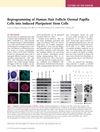Search
forLearn
2 / 2 resultslearn Neem Oil
natural substance from Neem tree with medicinal and pesticidal properties
Research
5 / 1000+ results
research Hair Follicle Generation by Injections of Adult Human Follicular Epithelial and Dermal Papilla Cells into Nude Mice
Injecting a mix of human skin and hair cells into mice can grow new hair.

research Human Fetal Scalp Dermal Papilla Enriched Genes and the Role of R-Spondin-1 in the Restoration of Hair Neogenesis in Adult Mouse Cells
Certain genes are more active in baby scalp cells and can help grow hair when added to adult mouse skin cells.

research Reprogramming of Human Hair Follicle Dermal Papilla Cells into Induced Pluripotent Stem Cells
Human hair follicle cells can be successfully transformed into different types of cells, but not more efficiently than other adult cells.

research Comparative Analysis of Stemness Between Dermal Papilla Cells and Human Dermal Stem/Progenitor Cells
Human dermal stem/progenitor cells can divide and differentiate more than hair follicle dermal papilla cells.

research Hair Matrix Germinative Epidermal Cells Confer Follicle-Inducing Capabilities on Dermal Sheath and High Passage Papilla Cells
Hair growth can be stimulated by combining certain skin cells, which can rejuvenate old cells and cause them to specialize in hair follicle creation.
Community Join
5 / 420 resultscommunity How ET-02 Works. Also no proof that it's better than Minoxidil. At least for now.
ET-02, a PAI-1 inhibitor, is not proven to be more effective than Minoxidil for hair loss. Other treatments like finasteride, dutasteride, PP405, and AMP-303 are also discussed, focusing on cellular senescence and oxidative stress.
community CRISPR Is Curing People Right Now. Genetic Hair Loss is Next?
CRISPR shows promise for treating hair loss by targeting specific genes. Current treatments include Minoxidil and finasteride, but CRISPR could offer a more precise solution, though it is still expensive and in early stages.
community Dht kills hair, but no one says why?
DHT affects hair follicles, contributing to hair loss, but the exact mechanism is unclear. Treatments like finasteride and minoxidil are used to manage hair loss, though they may have side effects and varying effectiveness.
community Topical Finasteride Doesn't Directly Reduce 5ar Enzyme on Scalp
Topical Finasteride doesn't directly reduce 5ar enzyme on scalp and has the same mechanism as oral, needing to go through the liver. Users debate the accuracy of this information and discuss various studies and experiences.
community Efficacy and Tolerability of N-Acetyl-Cysteine for Treatment of The Early-onset Androgenetic Alopecia in Men
N-Acetyl-Cysteine (NAC) was found to improve hair parameters in men with early-onset androgenetic alopecia, showing increased terminal hair count and decreased vellus hair count, with good tolerability. NAC, used alone or with minoxidil, may help due to its antioxidant properties, though its effectiveness can vary among individuals.